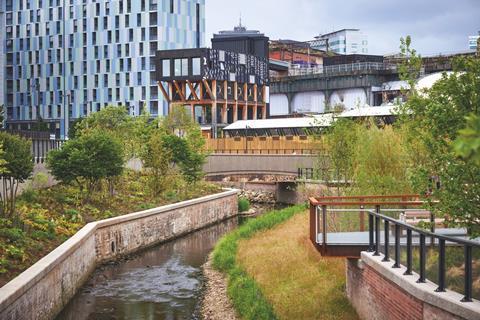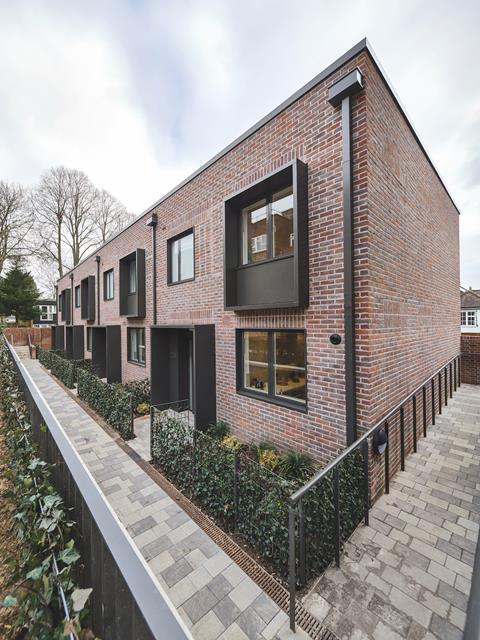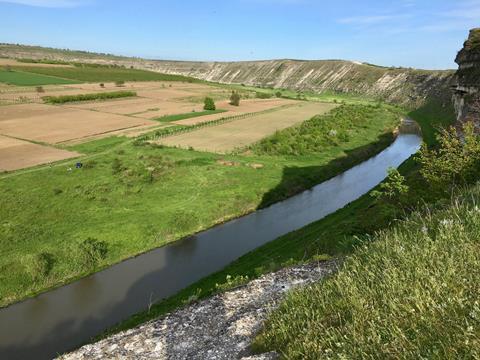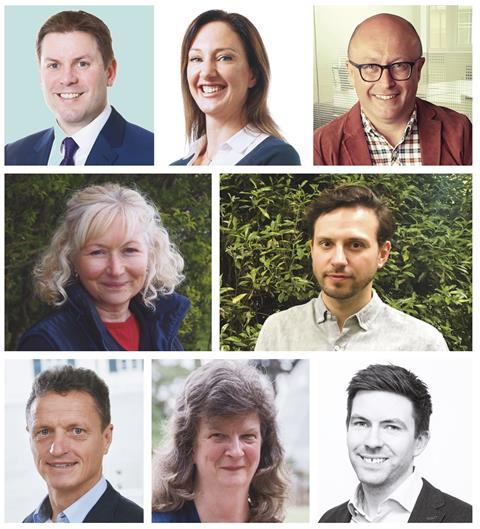At a roundtable hosted by ��ɫ����TV and Atkins, industry experts shared a range of solutions to the biodiversity crisis and how the construction industry might learn to embrace them

We have been losing species at a rapid rate, making life for all organisms on Earth much more difficult. The world’s biodiversity intactness is estimated at about 75%, far below the 90% threshold scientists see as safe.
The climate and biodiversity emergencies must be at the top of the built environment agenda and while net zero has been making headlines, far less attention has been placed on biodiversity loss. Global biodiversity conference COP15, which is due to take place later this year in Montreal, Canada, aims to change that.
��ɫ����TV magazine teamed up with engineering consultant Atkins, a member of the SNC-Lavalin Group, gathering a panel of experts to examine the issues and discuss potential solutions to this vast and complex problem. The discussion was chaired by ��ɫ����TV group technical editor Thomas Lane.
How serious is biodiversity loss?
“Looking at the UK, it’s embarrassing,” said Claire Wansbury, fellow and associate director of ecology at Atkins. “When you look at the statistics, we’re the most nature-poor country in the G7.”
Jayne Manley, chief executive of environmental charity Earth Trust, made an interesting point about the time we’re living in: “It’s called ‘Anthropocene’ for a reason.” An unofficial era of geologic time, the Anthropocene describes the present period in Earth’s history, from when human activity began to have a significant impact on the planet’s climate and ecosystems.
“We’ve created our Earth how it is now; we’ve created the UK,” Manley continued, “and we’ve shaped and changed every part of it; every ecosystem has been impacted by humans. And it’s deteriorated so fundamentally that we’re completely out of sync with the ecosystems that we depend on.”

There is not one singular cause of our biodiversity crisis. Big contributors include modern agriculture and built development, while in the background we are starting to see the impact of climate change. “Even on quite a small scheme, you can have things like lighting creating a barrier to wildlife movement. It may be happening in a very localised way but it all adds up,” said Wansbury.
Leigh Hughes, business growth and social value director at construction company Bouygues, believes “the interdependencies of the built environment and building in the UK, alongside agriculture, transportation and industry, have collectively presented a picture where biodiversity is as big a challenge as decarbonisation”.
Food security is another concern. “If we don’t look after biodiversity, we’re building one of our most significant food security issues,” said Wansbury.
Michael Obersteiner, director of the Environmental Change Institute at the University of Oxford, couldn’t agree more: “The best soils on Earth are now occupied by cities.” When settlements were created, the sites selected were often those that were best for biodiversity. Destruction was a direct result.
Obersteiner shared Switzerland’s approach to net zero targets and the trade-off of “soil points” that allows different values (for biodiversity, water, soil quality, and so on) to be attached to different pockets of land. This deals with the problem holistically and “allows for flexibility to reach targets”.
Where best to build
Richard Weeks, technical director at affordable housing developer EDAROTH, believes it is important to think about where we develop. “We’ve set up the business primarily to deliver homes on brownfield land, publicly owned land that is underutilised and often not attractive to traditional developers,” he said.

EDAROTH released a series of white papers investigating brownfield land in the UK and found that, for the 1.6 million households on a waiting list for a suitable home, there is a sufficient amount of developable brownland to potentially eradicate that list.
Brownfield land covers a broad scope, from land that is urban in nature and supports little biodiversity to sites that are overgrown and have developed into complex habitats. It might not be suitable for every project, but Weeks believes “there is huge potential there.” He added: “In the UK, we undoubtedly have a biodiversity crisis, and a climate crisis, but we also have a major housing crisis – and we need to find solutions that address all three of those things, hand in hand.”
More than one solution
Mike Hedges, director at Beard Construction, believes there are a number of ways to tackle the issue. “Just like there’s not one cause for the biodiversity crisis that we’re in, there’s not one solution either,” he said.
Hedges shared Earth Trust’s Earth Lab building as an example for designing with “the environment at the very forefront”. Earth Trust’s new learning building was cleverly designed with nature in mind, using natural materials such as straw insulation, glulam beams, rammed-earth walls and a wildflower roof. “All of those things can be utilised in most of the buildings that we see,” he said.
Kai Liebetanz, senior sustainability adviser at the UK Green ��ɫ����TV Council, said: “Engaging with your supply chain would be the solution that I can see – and trying to quantify your reliance on biodiversity and nature and where globally you have an impact. It’s all interconnected. And the solutions need to be targeted.”
Victoria Hutchinson, environment practice director at Atkins, believes that people have an important role to play. Funded by the European Bank for Reconstruction and Development (EBRD), Atkins’ Moldova project worked to rehabilitate the Bic river by opening it up into the centre of Chișinău, Moldova’s capital city. “The work we’ve done is a combination of climate resilience, reducing surface water flooding, improving biodiversity and the quality of the river water, and creating some amenity value.”
She added: “Part of the delivery of that solution was about getting people to work together effectively. There’s an important case for getting multiple stakeholders with different expertise around the table.”
It’s all in the planning
“We see an ever-increasing amount of questions around social value, operational net zero and embedded net zero,” Hughes said. “But in the strategic development plans of local authorities, section 106, you see very little around biodiversity. Should there be a mandate in terms of solutions?”
As the gateway to development, it seems obvious to address the biodiversity crisis through planning. “But the planning process is already a bit lethargic,” said Weeks. “Biodiversity net gain is due to be enshrined in the planning process, quite rightly, but it will be done as quite a standalone thing. What the planning process lacks is a holistic view.”
In the strategic development plans of local authorities, section 106, you see very little around biodiversity
Leigh Hughes, Bouygues
Obersteiner agreed. “If you were to optimise four outcomes (biodiversity, human welfare, and so on), you can come up with 100 different examples that are almost equal in terms of their outcome.” Typically, the planning process favours one solution, but what is needed is flexibility.
While many thought planning was not the answer, Hedges said he believes “it could be”. He explained: “Biodiversity is at the bottom end of what’s seemingly important to local authorities and it just needs to be elevated, with a much more integrated approach. It needs investment in planning teams.”
Good design
Atkins recently worked alongside National Highways to replace a standard bridge with a heathland green bridge design. “With a green infrastructure approach,” said Wansbury, “suddenly you’ve got something that’s delivering for wildlife, delivering for local communities, delivering for climate – it’s doing lots of things at the same time.”
Hughes believes biophilic design – the concept of designing direct and indirect nature into our spaces – is something that should be explored further. “We’re seeing biophilic design but only in large projects. Why aren’t we putting the principles of biophilic design into residential development?”

All the panellists seemed to agree that good design has an important part to play. “Good design doesn’t always have to come at an additional cost, although sometimes it does,” said Weeks. But with 300,000 homes needed per year and the deficit only increasing, “should we further restrict the delivery of much-needed homes because we can’t solve every problem on every site?”
Integrating ecosystems with the built environment, enabling deep connection between people and nature, creates a virtuous circle of mutual benefits for environmental and societal wellbeing – and is something Earth Trust keenly advocates.
“When we talk about construction, we tend to focus on the buildings, but we also need to be thinking about planning in and constructing access to green space. And that needs to be an absolute given,” said Manley.
Counting pennies
Hutchinson shared details of Mayfield Park in Manchester city centre, project managed by Faithful+Gould. The site will provide 1,500 new homes, alongside commercial, retail and leisure space. The park itself spans 6.5 acres and is home to a floodable meadow and wetlands. It is a project that benefits both people and nature, combined with an increase in the land value, which was a huge driver for Manchester city council and the developer.
“It’s unrealistic to think that high standards of regulation and legislation alone will drive biodiversity gain,” said Hutchinson. “It’s also the combination of making a great economic case for development that will really foster good practice in the UK and abroad.”
Liebetanz said: “We need to be thinking about how to channel private finance into nature, and talking about the value holistically is definitely the way forward.” Although he believes “the person paying for the nature-based solutions is often not the person receiving the benefits, so there can be a disconnect”.
UKGBC advocates for stakeholder benefits, listing the advantages of creating biodiversity and cross-checking that list with local stakeholders which could contribute financially. “If you can make a monetary case, then you can hopefully channel a lot of private funding into that area,” added Liebetanz.
It’s unrealistic to think that high standards of regulation and legislation alone will drive biodiversity gain
Victoria Hutchinson, Atkins
Hutchinson reflected on TCFD (Taskforce on Climate-related Financial Disclosures) reporting, which she considers really powerful. Businesses, particularly large and publicly owned ones, are required to complete climate-related financial disclosures, lending some transparency on the climate-related risks that companies are facing.
There is also a Taskforce for Nature-related Financial Disclosures, whose work is at a much earlier stage. Atkins is on the forum, and Wansbury is pleased that they have “looked to the Taskforce on Climate-related Financial Disclosures and they are wanting to create something that takes the same approach so that it will be familiar”.
Hedges believes that “one way of helping is through education and some clarity”. His team have uncovered a number of different ways to measure their progress and feel one single way would be “most valuable”.
Hedges added: “One way to encourage more responsible development is by offering mitigation on empty building rates based on the green credentials of the building.” It could lead to developers being more inclined to take risks.
Obersteiner said: “We’re in a new phase, pioneered by the carbon market, where we’re seeing more comprehensive economic approaches. Once we have more comprehensive planning, combined with economic instruments, then even the smaller-scale builders can participate.”
Weeks pointed to offsite manufacturing as part of the solution. EDAROTH builds homes using offsite manufactured products, mainly due to the reduction of impact on site during the delivery phase, but how as well as where we develop is important, he said.
Looking forward
“It’s very difficult when you have political decisions being made; it’s soundbite decisions of ‘we can either have nature or we can have growth’ – it’s nonsense,” said Wansbury. “If we do not protect nature, we will not have economic growth.”
“We’re in the middle of a series of crises,” said Manley. From the biodiversity crisis and climate crisis to the current housing crisis, as well the detrimental effects of not prioritising health and wellbeing. “The current planning and incentives for us to address all these challenges through construction are not working, and it’s complicated. They are not joined up – and it’s probably because we’re all trying to find our way through this.”
Manley went on to add: “It’s the examples of what has worked, can work, when people think differently, that are really going to challenge us as we try and put a new jigsaw picture together.
“I’m in awe of some of the projects we’ve been describing today – because if we can show how challenging it is and get the policy-makers to think differently about their approach, then it’s going to be those stories that make a big difference.”

Round the table
Chair: Thomas Lane, group technical director, ��ɫ����TV
Mike Hedges, director, Beard Construction
Leigh Hughes, business growth and social value director, Bouygues
Dr Victoria Hutchinson, environment practice director, Atkins
Kai Liebetanz, senior sustainability adviser, UK Green ��ɫ����TV Council
Dr Jayne Manley, chief executive, Earth Trust
Professor Michael Obersteiner, director, Environmental Change Institute, University of Oxford
Claire Wansbury, fellow and associate director of ecology, Atkins
Richard Weeks, technical director, EDAROTH

























